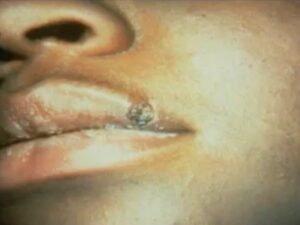Syphilis is actually on the rise, and there is a slight increase in the number of incidents of syphilis recently. California is the second most frequent location in the United States behind New York.
Don’t have time to read this article? We get it. Download the Diagnosing Vesicular Ulcerative Conditions checklist to get all the key information and images from this article plus all the other conditions we cover in the Dentist’s Guide to Oral Pathology.

Syphilis can be primary, secondary, or tertiary so we’ll just go through the stages.
Primary Syphilis

When primary syphilis occurs you have what is called the chancre at the site of inoculation.
Oftentimes the chancre at the site of inoculation is on the lip and it looks just like a secondary (recurrent) herpetic ulceration.
The difference is the chancre is not painful and has no prodrome. Patients may or may not have lymphadenopathy. If these lesions are biopsied, they will resolve and then the patient will go into the secondary syphilitic stage, or they may have dormant syphilis.
Related Reading: Understanding Oral Herpes: Primary Herpetic Gingivostomatitis
Secondary Syphilis Symptoms
Secondary syphilis occurs when it goes from localized to disseminated, and it is usually diagnosed ten weeks after the initial infection.
Clinical Features
The patients will have flu-like symptoms, malaise, fever, lymphadenopathy, and maculopapular cutaneous rashes that begin on the palms and soles. Not a lot of rashes will occur on the palmar aspects of the hands so that’s something that you need to think about.


Other oral manifestations of syphilis include mucous patches (image 1), condyloma lata (image 2), and split papules. These will spontaneously resolve within 3-12 weeks if not biopsied. Secondary syphilis can manifest as Lues Maligna, or malignant syphilis, in an immunocomprimised patient.
Tertiary Syphilis
Tertiary syphilis may develop quickly or the latency period can be up to a decade. This is a very serious condition. If syphilis is not treated in the early stages, it can cause severe complications.
Tertiary syphilis can affect multiple organ systems, including CNS involvement, heart failure, aneurysms of the ascending aorta, blood vessels, ocular involvement, granulomatous lesions, “gumma,” and several other oral manifestations.
Postgraduate Oral Pathology and Radiology Certificate
Learn more about the clinical and didactic skills necessary to evaluate and manage patients with oral diseases by enrolling in Herman Ostrow School of USC’s online, competency-based certificate program in Oral Pathology and Radiology.

